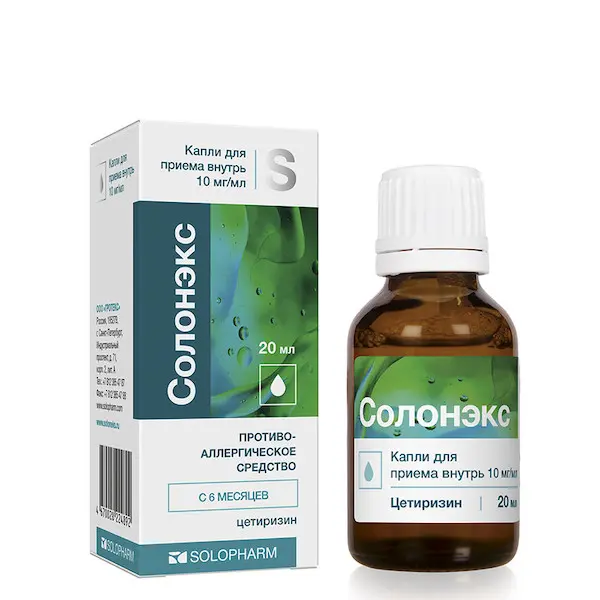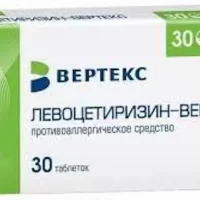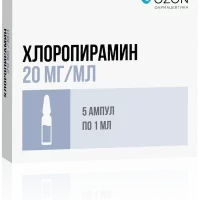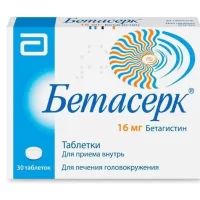Description
Solonex Pharmacodynamics
Cetirizine – the active substance of the drug – is a metabolite of hydroxyzine, belongs to the group of competitive histamine antagonists and blocks H,-his-tamine receptors.
In addition to its antihistamine effect, cetirizine also prevents and relieves allergic reactions: in a dose of 10 mg once or twice daily, it inhibits the late phase of eosinophil aggregation in the skin and conjunctiva of atopic patients.
Clinical efficacy and safety
Studies in healthy volunteers have shown that cetirizine at doses of 5 or 10 mg significantly inhibits the reaction in the form of rash and redness to high concentrations of histamine injected into the skin, but no correlation with efficacy has been established. A 6-week placebo-controlled study involving 186 patients with allergic rhinitis and concomitant bronchial asthma of mild to moderate course showed that administration of cetirizine in a dose of 10 mg once daily reduced rhinitis symptoms and did not affect lung function.
The results of this study confirm the safety of cetirizine use in patients with allergies and bronchial asthma of mild to moderate course.
In a placebo-controlled study, it was shown that administration of cetirizine at a dose of 60 mg per day for 7 days did not cause clinically significant prolongation of the QT interval. Administration of cetirizine in the recommended dose showed improvement in quality of life in patients with year-round and seasonal allergic rhinitis.
Children
A 35-day study involving patients aged 5-12 years showed no evidence of insensitivity to the antihistamine effect of cetirizine. Normal skin response to histamine was restored within three days of drug withdrawal with repeated use.
A 7-day placebo-controlled study of the drug in dosage form syrup involving 42 patients aged 6 to 11 months demonstrated the safety of the drug. Cetirizine was administered in a dose of 0.25 mg/kg twice daily, which approximately corresponded to 4.5 mg per day (the dose range was from 3.4 to 6.2 mg per day).
Use in children 6 to 12 months of age should only be prescribed by a physician and under close medical supervision.
Indications
The drug is indicated in adults and children 6 months and older for the relief of
– nasal and ocular symptoms of year-round (persistent) and seasonal (intermittent) allergic rhinitis and allergic conjunctivitis: itching, sneezing, nasal congestion, rhinorrhea, lacrimation, conjunctival hyperemia;
– Symptoms of chronic idiopathic urticaria.
It is possible to use in children aged 6 to 12 months only by prescription and under strict medical supervision.
Contraindications
– Hypersensitivity to cetirizine, hydroxyzine or any piperazine derivatives, as well as to other components of the drug.
– Terminal stage of renal failure (CK < 10 ml/min).
– Childhood age less than 6 months (because of the limited data on the efficacy and safety of the drug administration).
– Pregnancy.
Caution
– Chronic renal failure (in case of CKR > 10 ml/min, the dosage regimen should be corrected).
– Elderly patients (with age-related decrease in glomerular filtration rate).
– Epilepsy and patients with increased seizure activity.
– Patients with predisposing factors to urinary retention (see section “Special indications”),
– Childhood under 1 year of age.
– Breast-feeding period.
– When concomitant use with alcohol.
Dosage and administration
- Orally, drip into a spoon or dissolve in water.
- The amount of water to dissolve the drug should correspond to the amount of liquid that the patient (especially a child) is able to swallow.
- The solution should be taken immediately after preparation.
- Adults
- 10 mg (20 drops) 1 per day.
- Elderly patients
- There is no need to reduce the dosage in elderly patients if renal function is not impaired.
- Patients with renal impairment
- As cetirizine is mainly excreted by kidneys (see subsection “Pharmacokinetics”), in patients with renal insufficiency the drug dosage regimen should be adjusted according to renal function (CK value) if there is no alternative treatment.
- CK for men can be calculated based on serum creatinine plasma concentration using the following formula:
- [140 – age (years)] x body weight (kg)
- CK (ml/min) = 72hCK=y,voro>g/DL)
- CK for women can be calculated by multiplying the value obtained by a factor of 0.85. Dosing in adult patients with renal failure
- Renal failure CKR (ml/min) Dosing regimen
- Norm >80 10 mg once daily
- Mild 50-79 10 mg once daily
- Moderate 30-49 5 mg 1 time daily
- Severe 10-29 5 mg every other day
- Tertiary stage – dialysis patients < 10 The drug is contraindicated.
- Patients with hepatic impairment
- No dosing adjustment is necessary in patients with hepatic dysfunction only.
- In patients with hepatic and renal dysfunction a dosing adjustment is recommended (see table above).
- Children
- Administration in children aged 6 to 12 months is possible only by prescription and under close medical supervision.
- Children 6 to 12 months of age
- 2.5 mg (5 drops) once daily Children from 1 to 6 years of age
- 2.5 mg (5 drops) 2 times a day Children 6 to 12 years of age
- 5 mg (10 drops) 2 times a day
- Children over 12 years of age
- 10 mg (20 drops) once a day
- Sometimes an initial dose of 5 mg (10 drops) may be sufficient if satisfactory symptom control is achieved.
- In children with renal insufficiency, the dose is adjusted for CK and body weight.
- If there is no improvement after treatment, or if symptoms worsen or new symptoms develop, consult a physician.
- Use the drug only according to the indications, the route of administration and the doses specified in the instructions.





